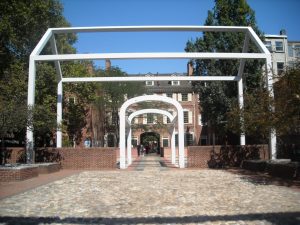Franklin Court is a historic site located at 322 Market Street in Philadelphia, Pennsylvania. The site includes the remains of Franklin’s home and print shop, which were destroyed by fire in 1790, and the reconstructed structure of his former carriage house. Visitors can tour the site and learn about Franklin’s life and work.
History
In 1763, Benjamin Franklin built a house at 322 Market Street. Since he often traveled overseas, Franklin did not live in the house full-time. However, he did reside there every time he went home to Philadelphia. When his only daughter, Sarah, got married on October 29, 1767, she lived there with her husband, Richard Bache.
Franklin lived in England during most of the American Revolution. His house in Philadelphia sometimes became a meeting place for soldiers, politicians, and other notable figures that fought for the Continental Army. After his wife’s death, his daughter acted as his political hostess in the house.
When Franklin returned to America in 1775, he moved into the house permanently. He added a print shop for his grandson, Benjamin Franklin Bache, to the property in 1787. Benjamin Bache then went on to publish the Philadelphia Aurora in 1794, a newspaper that was critical of the Washington and Adams administrations, in that same print shop.
Unfortunately, Franklin was not able to see the Philadelphia Aurora as it was published, as he died in his house on April 17, 1790, due to pleurisy. After his death, most of the estate was passed on to Sarah. Years later, in 1812, the house was demolished during a courtyard redevelopment project. The site is now managed by the National Park Service as part of Independence National Historical Park.
Design and Architecture
Franklin Court was designed by the architectural firm Venturi, Raucht, and Scott Brown and opened to the public in 1976 as part of the United States Bicentennial celebration. The site includes two “ghost structures” that were created to suggest the outline of the long-demolished buildings within the courtyard. The larger frame which is 49’5″ x 33′, by 50’6″ tall at the crest of the roof depicts the Franklin House, while the smaller frame which measures 48′ x 20′, by 48 ft. at the crest of the roof represents the print shop.
The design was the result of a lack of historically accurate information to properly rebuild the buildings, as well as the emerging views about architectural restoration at the time. This design choice by the firm was controversial when the site opened but has since been praised as an innovative way to commemorate history. It was even used for the restoration of other historic sites across the country.
As a Museum
The Benjamin Franklin Museum includes interactive exhibits, original artifacts, and documents. The Franklin Court Printing Office even features two working replicas of 18th-century printing presses. You can watch a ranger demonstrate how the press works and even try your hand at printing. The office has a bindery, a typesetting area, and a newspaper office that belonged to Franklin’s grandson and namesake. The site also offers ranger-led tours, educational programs, and special events.
The museum was closed in 2011 for major renovations and reopened in August 2013. The exhibit area contains a series of five interactive rooms that tell the stories of Franklin’s life, work, and legacy. They also have short films in each room that visitors can check out to know more about Franklin. Each room was designed to represent one of his core five character traits: ardent and dutiful, ambitious and rebellious, motivated to improve, curious and full of wonder, and strategic and persuasive.
